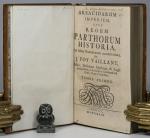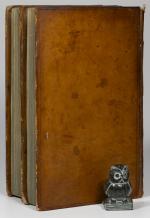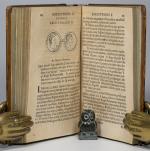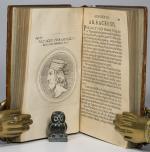1. Arsacidarum Imperium, sive, Regum Parthorum historia / 2. Achaemenidarum Impe…
1. Arsacidarum Imperium, sive, Regum Parthorum historia / 2. Achaemenidarum Impe
|
J. [Jean] Foy Vaillant / [Charles de Valois de la Mare]. 1. Arsacidarum Imperium, sive, Regum Parthorum historia / 2. Achaemenidarum Imperium, sive Regum Ponti, Bosphori, et Bithyniae Historia. Ad fidem Numismatum accommodata. [The Empire of the Arsacids, or the History of the Kings of Parthia & The Empire of the Achaemenids, or the History of the Kings of Pontus, Bosphorus, and Bithynia. Arranged according to the testimony of the coins.] Two Volumes. Paris, [No Publisher], 1728. 19 x 12 cm. Vol.1: Title pages, (14), 407 pages, 47 pages [Index]. / Vol.2: Title page, (14), 438 pages. Numerous small engravings and vignettes. Contemporary calf. Red and black spine labels. Gilt titles and decorations. Marbled end papers. Blue-Greenish Edges. Very good condition. Some shelf wear, rubbing and bumping with small material losses to spine ends and corners (see images). Ex Library with library card holders on front paste downs. A few blind library stamps. Some age darkening to paper, otherwise internally clean. Half of the spine label of volume 1 missing. A very nice set in sturdy attractive bindings. Jean Foy-Vaillant (1632 – 1706) first became interested in numismatics when a farmer brought him ancient coins that he had found in the area of Beauvais. He studied these coins meticulously and deciphered their inscriptions. This ignited a passion in the young Vaillant, who soon travelled to Paris to meet with the renowned numismatist Peter Seguin. Before long, First Minister of State Jean-Baptist Colbert sent Foy-Vaillant on a mission to Italy and Greece to collect coins for the collection of the Royal Museum. His contribution doubled the size of the collection, for which he prepared a catalogue in two volumes, ‘Numismata Imperatorum Romanorum Praestantiora a Julio Caesare ad Postumum et Tyrannos’ [The Rarer Coins of the Roman Emperors from Julius Caesar to Postumus and the Tyrants].
Our price: EUR 600,-- |

|







